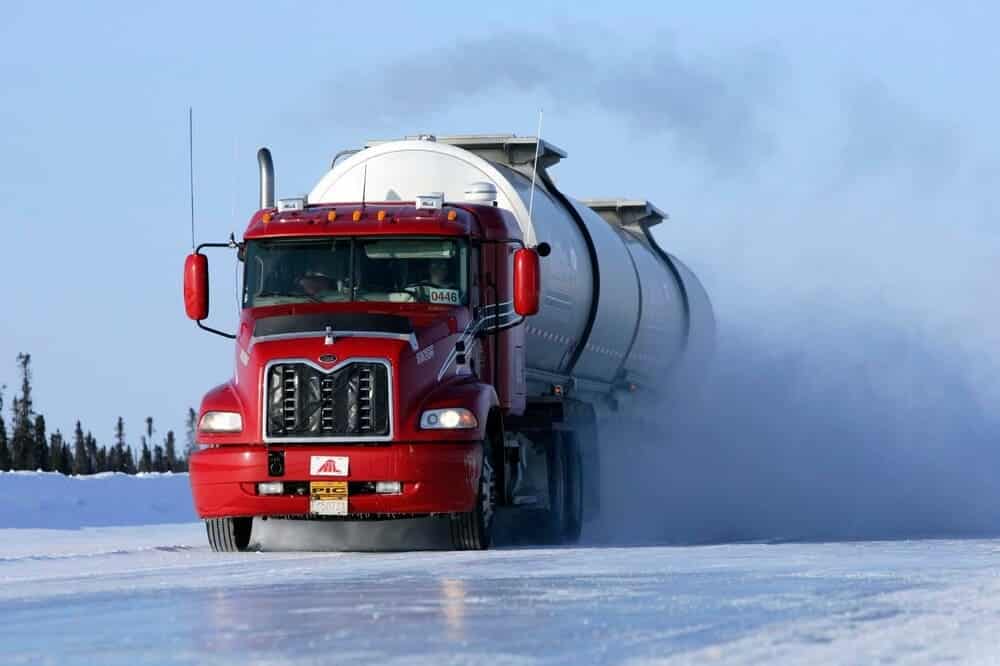

August 9, 2023

1533 Views

5 min read
How Dangerous Is Ice Road Trucking
Page Contents
Most truck drivers around the country avoid venturing onto icy roads due to the inherent risks involved. However, truck drivers in areas such as Alaska have no choice but to navigate their vehicles across roads completely fashioned from ice. The viability of their transportation from one destination to another is contingent upon these distinctive infrastructural provisions.
Nonetheless, one cannot overlook the potential predicaments that may arise, particularly if you have experienced the unnerving sensation of ice succumbing beneath your weight or inducing a sudden loss of balance. So how dangerous is ice road trucking?
What Is an Ice Road?
Ice roads are temporary transportation routes constructed over frozen bodies of water such as lakes and rivers. Primarily found in the northern regions of Alaska, Canada, Sweden, Russia, Finland, Norway, and Iceland, these roads are composed entirely of ice.
To make a suitable driving surface, ice road construction involves using plows to remove and compress snow, resulting in a firm and even roadway atop thick layers of ice. Once they make this happen, these ice roads become sturdy and can sustain the weight of large trucks and their cargo, weighing up to 100,000 pounds. Maintaining continuous movement while transporting heavy loads is critical to ensuring safe passage along these routes.
Yearly, these treacherous paths are constructed afresh, employing specialized crews equipped with heavy-duty plows, radar systems, and water sprays to enhance the smoothness of the road’s surface. These temporary routes are vital in facilitating the transportation of goods and supplies, particularly to isolated communities.

Is Ice Road Trucking Really That Dangerous?
Ice road drivers navigate treacherous conditions, venturing into areas others are unwilling to travel, such as snowstorms, ice-covered roads, and freezing temperatures. Combining these elements much more increases driving hazards, mainly when operating large rigs. In addition to the inherent challenges of sliding and reduced control on icy surfaces, drivers must contend with the potential for mechanical issues as temperatures plummet to extreme lows, occasionally reaching as low as -45°F.
For certain ice road truckers, driving on the road is a luxury. This is because these drivers, predominantly in the northern regions of Alaska and Canada, travel on frozen lakes, rivers, and ponds. These specialized drivers recognize that the key to survival lies in maintaining the continuous movement of their trucks. By ensuring that the 100,000-pound truck remains in motion, the ice is unlikely to give way; however, should the rig come to a halt, it is liable to collapse, as it can only support a load of approximately 60,000 pounds.
Moreover, drivers face the danger of developing hypothermia alongside the perilous driving conditions and the genuine risk of truck malfunctions. Other risks ice road truckers face include common threats, such as accidents, avalanches, breaks along the ice road, whiteouts, and the associated salary prospects.

FOR COMPREHENSIVE FLEET
MANAGEMENT SOLUTIONS
Ice Road Truckers: Most Dangerous Roads
In Canada’s northernmost regions, a network of highways spanning over 3,300 miles is characterized by hazardous conditions. Among these treacherous roads, Yellowknife in Canada’s Northwest Territories has perilous routes. Most of the year, remote communities happen to rely on air transportation or barge to access. However, during the winter season, a vital connection is established as ice road truckers make the journey across the marbled blue ice in Yellowknife and various isolated communities across Canada.
Another example of dangerous roads for ice road truckers is the Kuskokwim River in Alaska, which recently made history as one of the most hazardous and prolonged winter roads. Stretching approximately 355 miles from Tuntutuliak to Sleetmute, this route presents significant risks due to river hazards, posing a challenging expedition for truckers.
Another notorious route is the Tibbitt to Contwoyto road, initially constructed in 1982 to serve mining operations in Canada’s Northwest Territories and Nunavut regions. It spans around 370 miles, with approximately 85 percent of its length traversing frozen lakes.
The Wapusk Trail, which connects Gillam, Manitoba, to Peawanuck in Canada, is the longest seasonal winter road in the country, spanning 467 miles. The road’s considerable length contributes to its hazardous nature, as conditions along the route can rapidly change from one end to the other, posing significant challenges for truckers.

Off-Season Work for Winter Road Truckers
The duration of winter long-haul trucking season typically spans approximately three months. Throughout the remainder of the year, the thickness of the ice needs to be increased to support the substantial weight of equipment, trailers, and trucks. Consequently, many truckers pursue alternative forms of employment to make money during the extended off-season.
Many truckers work in a construction company, while others may explore opportunities within the truck driving industry. Some truckers decide to spend time at home with their family to counterbalance the extended periods spent away from home during the peak season.
Despite the brevity of the winter season, these truckers often get paid a substantial income equivalent to a full year’s pay for many people. Several reports show that ice truck drivers get paid over $100,000 per season. Besides, even truckers who do not make so much money can still supplement their trucking earnings with income from their off-season jobs.
Job Outlook for Seasonal Truckers
Ice road trucking presents a challenging yet potentially lucrative opportunity within the trucking community, particularly during a short seasonal window. The compensation for ice road trucking exceeds that of an average professional trucking job, primarily to compensate for the heightened dangers and risks of navigating icy roads.
To qualify for an ice road trucking position, drivers typically possess extensive experience, as leading trucking companies prioritize safety and proficiency in their workforce before entrusting them with such a demanding task. This specialized trucking industry sector operates in a close-knit environment, with drivers and companies working closely together. Consequently, newcomers may need help establishing themselves.
Truck drivers willing to work on seasonal winter routes can contact FleetCare. Our team at FleetCare can assist in identifying prospective opportunities that align with your preferences and skill set.
Sign up for Exclusive Trucking Tips
Test







